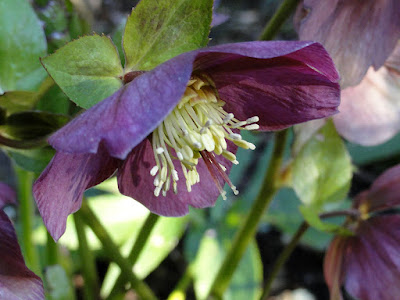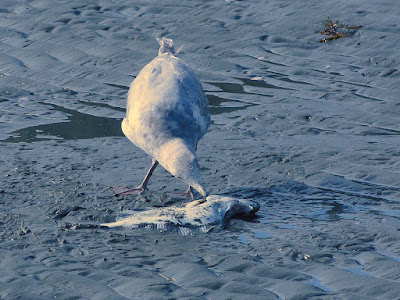I promised you recipes, didn't I? This is what I gave the work crew for lunch last weekend: albóndigas en chile verde (that's meatballs in green sauce), white Mexican rice, and frijoles de olla (beans in a pot, literally). Salad, veggies, cheeses and cold meats, blue corn tortilla chips and chipotle/raspberry dip (
Mrs. Renfro's) on the side.
Albóndigas en chile verde
This is an old family favourite, simple to make, good cooked ahead, and an easy dish to modify according to the spiciness tolerance of the guest list.
You will need
tomatillos, serrano peppers, fresh garlic, and onion for the sauce, lean ground beef and ground pork, an egg, and "filler" (I like to use raw rice, but oatmeal will do) for the meatballs. Fresh cilantro is nice with this, if you can get it.
Sauce:
You need about a double handful of tomatillos for 4 people. Check under the husk, and pick ones with firm, smooth skin, preferably of the paler, yellow-green shades. Darker green ones work, but will not be as sweet.
 |
Tomatillos, or tomate verde, as they called in central Mexico.
Image from Wikipedia |
Green serrano peppers. Must be fresh, not pickled. You can substitute with fresh jalapeños, but the flavour will be different, and they will not be as spicy. Three large serranos usually are enough for that double handful of tomatillos.
- Remove husks of tomatillo. Wash. Put in roomy pot with water to cover.
- Wash serranos and remove stem. Add to tomatillos.
- Peel several cloves of garlic, to taste, and add to the pot.
- Bring to a boil and simmer until the tomatillos are soft. Cool.
- Put tomatillos, garlic, and one* of the peppers in a blender, blend until only the seeds are visible.
- *If you're not worried about spiciness, add the lot. Otherwise, taste the blended sauce, and add the other chiles one by one, blending and tasting after each addition. You can go a bit spicier than you want the finished product.
- In a dry pot, heat a tablespoonful of oil. (Mexican cooks may use pork lard instead.) Do NOT use olive oil; it kills the flavour of the tomatillos.
- Add a few tablespoons of finely chopped onion to the oil; stir until it starts to brown on the edges, then add the tomatillos, all at once.
- When this comes to a boil, simmer for a few minutes, then add salt to taste.
(This basic sauce can be used with many dishes. Try it drizzled over tortilla chips, topped with a bit of grated cheese, and zapped in the microwave for a quick appetizer. Or pour it generously, boiling hot, over fried eggs. Yum!)
Now for the meatballs:
- Combine more or less equal amounts of ground beef and ground pork. Exact proportions are not necessary. Quantities vary; about a quarter pound per person serves my family. Heavy meat eaters, add another 50%.
- Add one raw egg, and a good handful of raw rice. Mix well by hand. (Wash your hands first, of course.)
- Form into smallish balls and drop gently, one by one, into the simmering sauce, making sure the sauce keeps just on the boil. Stir occasionally, very gently, so as not to break up the meatballs, just enough to let them all settle into the liquid. Add a bit of boiling water if the sauce becomes too thick.
- Simmer until the rice is done, or about 15 to 20 minutes. Add salt to taste.
- Done! Either serve immediately, or cool and refrigerate up to 48 hours.
This goes nicely with white rice. A dollop of sour cream and a teaspoon of chopped cilantro on top makes a good garnish.
I cut a few corners this Saturday because we were so busy, and used IKEA meatballs, which are already cooked. They're half pork, half beef, but the filler is too pasty. I had to simmer them for a while to let the flavour penetrate. They worked, but they weren't as good; they added a bit of greasiness and brown colour to the sauce. The crew liked them; 10 people ate most of what I had calculated for 16; but I won't do that again. It's worth it to take the extra time and make the meatballs from scratch, as I usually do.
Now, back to my critters and my garden ...
















































